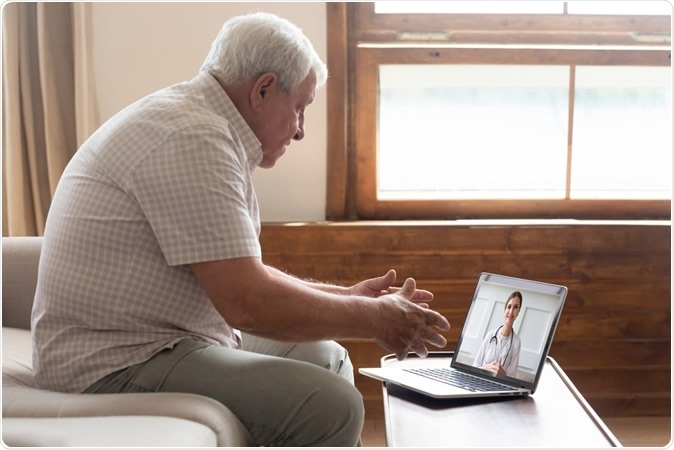As COVID-19-related social isolation and distancing make it increasingly difficult for people with neurological conditions to access routine medical care, the crisis is transforming the way care is being delivered to these vulnerable individuals, according to neurology service providers.

Viewpoint: The Coronavirus Disease 2019 Crisis as Catalyst for Telemedicine for Chronic Neurological Disorders. Image Credit: fizkes / Shutterstock
Reasons for the rapid shift towards telemedicine
An opinion piece recently published in JAMA Neurology and written by neurologist Bastiaan Bloem (Radboud University Medical Centre, the Netherlands) and colleagues have outlined the reasons for this rapid shift towards telemedicine in delivering neurology care during the COVID-19 pandemic.
Many individuals with neurological conditions would be at an increased risk if they caught COVID-19, owing to factors such as advanced age in cases of dementia, respiratory problems in cases of amyotrophic lateral sclerosis, or the use of immunosuppressants in cases of multiple sclerosis.
This has led to an increase in the delivery of remote neurology care, and for several reasons, healthcare professionals have become increasingly aware been that this care would be best delivered as near to a patient’s home as possible.
Firstly, sporadically occurring complications such as seizures are not reliably reported by patients during outpatient visits, especially in cases of impaired cognition.
Secondly, how patients are responding to treatments may be difficult to ascertain through outpatient appointments, especially in cases where the response changes over time.
Thirdly, observing patients in the clinic may not provide a reliable picture of how a patient is really functioning. For example, those with Parkinson’s might move well during clinical examinations even though they experience severe movement problems whilst at home.
Furthermore, visiting patients at home enables a better understanding of their everyday environment. It also provides more patient confidentiality, thereby avoiding the stigma that can be associated with visits to a psychiatry clinic, for example.
In addition, outpatient visits can be inefficient and unsafe; they may involve journeys that take hours, long waits in crowded areas, the potentially dangerous use of a car, and the risk of falling when trying to exit the vehicle.
The advantages of telemedicine
Bloem and colleagues say delivering neurology care through videoconferencing has been associated with similar outcomes to those seen with outpatient visits, whilst also being more efficient.
Research has also shown that home-based interventions can be carried out through telemedicine, including activity-based training stroke survivors, for example, which was found to be as successful as when the training is delivered in the clinic.
Telemedicine can also be used to monitor patients remotely via sensors attached to their bodies, watches, phones, or clothes, for example, or sensors placed within the home. Complications such as falls, problems with gait, and tremors all appear to be easy to measure and monitor.
Studies have shown that monitoring can be carried out successfully passively - with patients wearing sensors that monitor falls taken in the home, for example, as well as actively, with patients making entries in an e-diary at certain times of the day to record symptoms such as pain.
Together, such examples show telemedicine seems to be a suitable approach for monitoring neurological diseases.
“Importantly, these remote monitoring options, by offering reliable insights into issues that matter most to patients, will empower clinicians in delivering tailormade counseling to patients via videoconferencing, because such counseling remains the largest component of the neurology services that we offer,” write Bloem and colleagues.
“COVID-19 crisis has accelerated the introduction of telemedicine”
The researchers say that although it seems counterintuitive that the evidence supporting remote monitoring has not yet led to its widespread implementation, “it is remarkable to appreciate how the current COVID-19 crisis has accelerated the introduction of telemedicine.”
Patients now have a greater appreciation of the need for remote monitoring, and the rapidly increasing emergence of telemedicine in daily practice has meant fewer objections as people’s fears are alleviated. Many had mistakenly thought that telemedicine could only be used for talking to patients, when, in fact, simple assessments such as dexterity tests can be carried out remotely. Another concern was that the approach would have to be limited to younger people, but during the COVID 19 crisis, it has become increasingly clear that many older individuals have familiarized themselves with using smartphones and video conferencing.
“We hope that the telemedicine and remote monitoring advances will persist after the crisis has passed,” say Bloem and colleagues.
“Telemedicine for chronic neurological disorders should become part of the new normal rather than the exception. Governments, health care systems, and payers should be encouraged to continue to embrace the new age of access from home, even after the pandemic passes,” they conclude.
Journal reference:
Bastiaan R. Bloem, E. Ray Dorsey, MD, Michael S. Okun, MD, The Coronavirus Disease 2019 Crisis as Catalyst for Telemedicine for Chronic Neurological Disorders, doi:10.1001/jamaneurol.2020.1452, https://jamanetwork.com/journals/jamaneurology/fullarticle/10.1001/jamaneurol.2020.1452